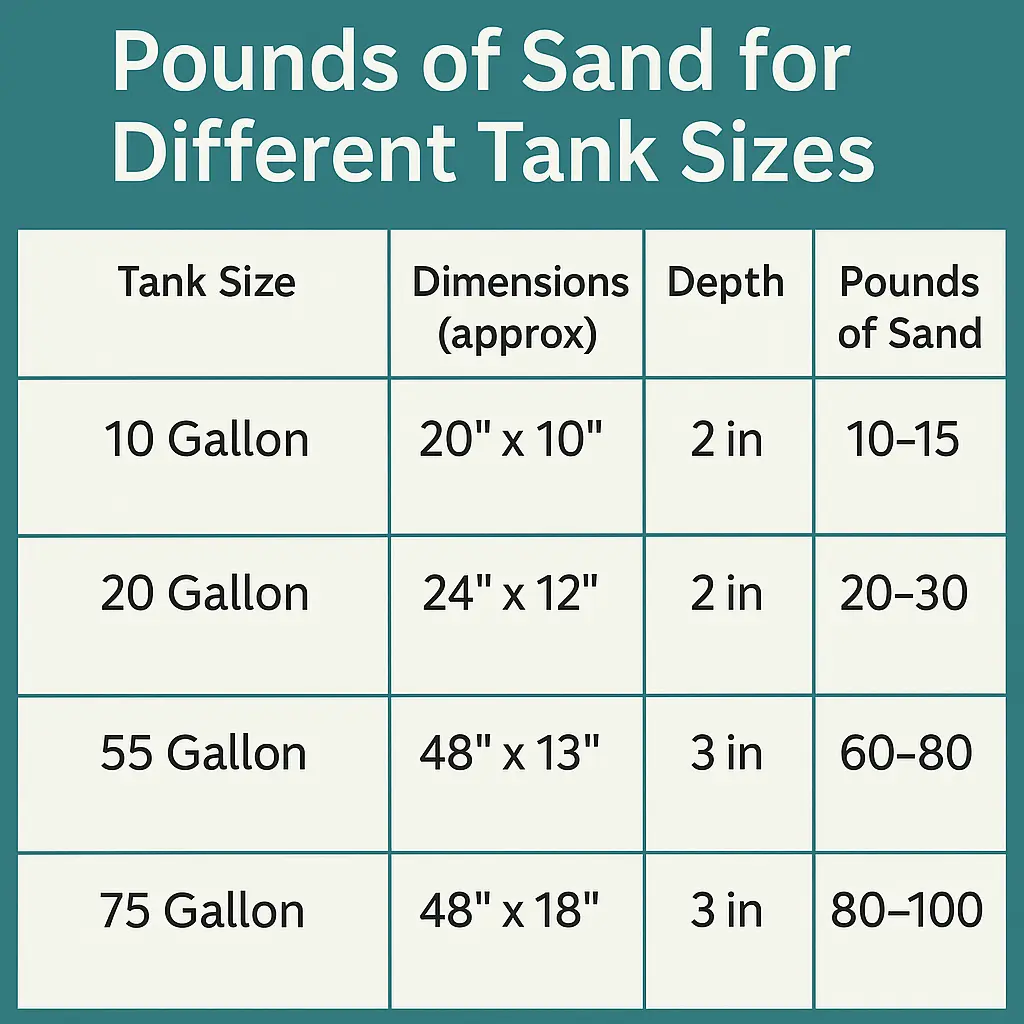🪸 Aquarium Sand Calculator
Calculate exactly how much sand your tank needs—based on shape, dimensions, and depth. Choose units, sand type, and tank presets for personalized results.
Tank Setup
📦 Sand Estimate Summary
Enter tank details above to calculate how much aquarium sand you need.
Aquarium Sand Calculator

Created by James S. Lockwood
With a background in botany and ecological sciences, James specializes in creating practical tools and resources to help gardeners, farmers, and plant enthusiasts optimize their green spaces.
Choosing the right amount of sand for your aquarium isn’t just about aesthetics—it affects water quality, plant health, and even the behavior of your fish. But how much sand do you actually need?
It depends. Tank size, desired substrate depth, and even the type of fish you’re housing all play a role. Some hobbyists swear by deep beds, others stick to minimal layers. The truth is: there’s no perfect answer for everyone—but that’s where a tool like our Aquarium Sand Calculator can help.

Table of Contents
How the Aquarium Sand Calculator Works?
At its core, the calculator estimates the volume of sand based on your tank’s dimensions and the depth of substrate you want.
You simply enter the length, width, and desired depth of your sand bed. For added accuracy, you can also select the type of sand—whether it’s fine, coarse, or somewhere in between. The tool then tells you how much substrate you’ll need in pounds, kilograms, and liters.
Some aquarists like to round up, just to be safe. Others prefer precision down to the decimal. Both approaches are valid—after all, it’s your tank.
Recommended Sand Depths for Different Tank Types
This part often sparks debate. Some fishkeepers advocate for shallow beds to avoid detritus buildup. Others claim deep sand beds are essential for natural filtration.
Here’s a general guide:
Freshwater aquariums: 1–2 inches
Planted tanks: 2–3 inches
Saltwater or reef tanks: 3–4 inches
Of course, these numbers aren’t set in stone. You might find that a 2-inch bed feels too thin in a tall tank, or that a 4-inch reef bed looks too bulky. In the end, personal preference plays a bigger role than most guides admit.
According to University of Florida’s IFAS Extension, substrate depth and type can significantly affect aquarium plant health and water quality.
How Much Sand for Common Aquarium Sizes?
📏 Tank Size vs. Sand Needed
Tank Size: 10 Gal (20x10")
Recommended Depth: 2"
Sand Needed: ~5.5 L / ~8.3 kg
Tank Size: 20 Gal Long (30x12")
Recommended Depth: 2.5"
Sand Needed: ~9.8 L / ~14.5 kg
Tank Size: 29 Gal (30x12")
Recommended Depth: 2.5"
Sand Needed: ~11.5 L / ~17 kg
Tank Size: 40 Gal Breeder (36x18")
Recommended Depth: 3"
Sand Needed: ~19.8 L / ~29 kg
Tank Size: 55 Gal (48x13")
Recommended Depth: 2.5"
Sand Needed: ~20.5 L / ~30 kg
Tank Size: 75 Gal (48x18")
Recommended Depth: 3"
Sand Needed: ~28.3 L / ~42 kg
⚠️ Estimates are based on typical tank footprints and average sand density (~1.5 kg/L). Use the Aquarium Sand Calculator for custom setups.
Sand vs Gravel – Which One Should You Choose?
Aquarists are famously divided on this question. Some love the smooth, natural look of sand. Others find gravel easier to clean and better for water flow.
That said, many aquarists choose a hybrid approach—gravel in the back, sand in the front for aesthetics. It’s unconventional, but surprisingly common.
Sand Pros
- Looks natural and clean
- Easier for bottom dwellers to sift through
- Prevents debris from sinking too deep
Sand Cons
- Can compact over time, risking anaerobic zones
- More difficult to vacuum during maintenance
Gravel Pros
- Better water flow between particles
- Less chance of compaction
- Easier to clean, especially with a siphon
Gravel Cons
- Not ideal for fish that like to burrow
- Can trap uneaten food and lead to spikes in ammonia
As your substrate settles and plants begin to root, you might ask: how long before I should replant or reposition aquatic plants? It’s a common question, especially when using new sand or adjusting depth. Check out our guide on how long before replanting aquatic plants for tips on timing, signs to look for, and how to avoid transplant shock.
Sand for Freshwater vs. Saltwater Tanks
Although sand is common to both, the requirements differ based on water chemistry, inhabitants, and filtration style.
For Freshwater Aquariums:
Use inert substrates that won’t affect pH or hardness.
Fine sand is ideal for planted tanks or small fish that like to dig.
Avoid calcium-rich sands, which can increase hardness unnecessarily.
For Saltwater or Reef Aquariums:
Aragonite sand or crushed coral is preferred—it buffers pH and adds essential minerals.
Live sand can help establish beneficial bacteria more quickly.
Deep sand beds are sometimes used to encourage anaerobic bacteria that break down nitrates, but they must be managed carefully.
Some reef keepers insist on deep beds; others now prefer bare-bottom tanks for better control. There’s no universal truth here—just trade-offs.
How Much Sand for a 10, 20, 55, or 75 Gallon Aquarium?
If you’re not a fan of math, here’s a simplified table that gives a ballpark estimate based on standard tank dimensions and an average sand bed depth.

These values can vary depending on grain size and how level your substrate is. Some people slope their sand higher in the back for depth perception, which subtly increases the total sand needed.
Want to skip the guesswork? Try our Aquarium Sand Calculator—it adjusts for depth, dimensions, and even sand density.
Aquarium Sand Types: Which One is Right for You?
Not all sand is created equal. Choosing the right type affects both the look and the health of your aquarium.
Here are the most common options:
Fine aquarium sand: Smooth, natural-looking, and ideal for bottom-dwelling fish like loaches or cory cats. It’s easier on their skin but tends to compact over time.
Coarse sand or crushed coral: Offers better water flow and is less likely to compact, but can be too abrasive for delicate species. Often used in reef or cichlid tanks.
Live sand (saltwater): Pre-seeded with beneficial bacteria, used mainly in marine setups. It can help kickstart biological filtration, though some hobbyists debate its long-term value.
Play sand (budget alternative): It’s cheap, but usually not recommended unless heavily rinsed and chemically tested. Some brands contain silicates or dust that can cloud the water and stress fish.
Many aquarists end up experimenting with a few types before settling. A lot depends on the tank’s setup and personal preference, not just the textbook answer.
How to Calculate the Right Sand Bed Depth?
Calculating the correct sand bed depth involves more than just picking a number. You have to consider your tank’s purpose (planted, reef, freshwater), the types of fish or invertebrates you’re housing, and how much maintenance you’re willing to do.
As a general rule:
Shallow beds (1–2 inches) are easier to clean and reduce the risk of anaerobic zones.
Moderate beds (2–3 inches) work well for planted tanks, allowing root systems to spread.
Deep beds (3–4+ inches) are often used in reef aquariums for nitrate-reducing zones—but can trap waste if not managed properly.
Use this formula for a more precise estimate:
Tank Length (in) × Width (in) × Desired Depth (in) ÷ 21.6 = Pounds of sand needed
Or, you can just use our Aquarium Sand Calculator to do the math for you. Most people don’t want to calculate volume every time they set up a tank.
FAQs – Aquarium Sand Bed Calculator
How much sand do I need for a 55-gallon aquarium?
For a standard 3-inch sand bed, you’ll need around 60 to 80 pounds of sand. That said, if your tank houses burrowing fish or live plants, you may want closer to 90 pounds for better coverage.
What’s the best substrate for freshwater fish tanks?
Fine sand is popular, especially for soft-bellied species like corydoras. But some aquarists still prefer rounded gravel to reduce compaction. Either works—as long as it’s aquarium-safe and doesn’t alter water chemistry.
Can I use play sand in my tank?
Technically, yes. It’s affordable and often looks clean. But be warned—it requires extensive rinsing, and some brands contain additives or contaminants that aren’t fish-friendly. Most experts recommend sticking with aquarium-grade sand unless you know exactly what you’re buying.
Bonus Tools & Calculators
Once you’ve figured out your sand needs, you might also want to explore related tools:
These are especially useful if you’re setting up a planted tank or trying to optimize space in a nano setup.
Disclaimer
The Aquarium Sand Calculator provided on this page is intended for general informational and estimation purposes only. While we strive for accuracy, individual aquarium needs may vary based on tank shape, substrate type, and stocking choices. Always verify measurements and consult with experienced aquarists or professionals before making substrate purchases. PlantCalculators.com is not liable for any outcomes resulting from the use of this tool.
